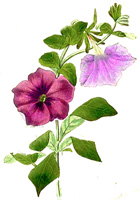Welcome to my blog, and garden. Also, welcome to my friends from Sisterhood Stories. If you have time today, please follow the blog links through "Sisterhood Stories." These are my talented and creative friends, and we link our blogs together. After you have visited here, please visit Sue at http://themercerie.net/blog/
In the flower bed in front of my house, I was originally inspired to create a "mini version" of Claude Monet's, Giverny Rose Garden. I planted a variety of roses in different sizes, colors, and species, with hopes that my flowers would give an impressionist impression.
This is Claude Monet's Garden at Giverny (photo credit shogunangel at flickr)
Here's another view of Monet's Rose Garden, I would so love to visit. (photo credit Valeria)
This is a video link to Monet's Garden; notice he lived to 86, one of the benefits gardening:
This year, I'm in the mood to streamline my flowers, and create a more "tidy" garden styling. My goal this January is to take out the multi-colored roses I've have had for years, and replace them with one type of rose, on the picket fence. I'm leaning toward getting roses from the David Austin catalogue.
David Austin Roses are show stoppers. They're great subjects for photographers, and gardeners. I just wonder if they will thrive in my California garden? If you want to swoon, I've pinned some stunning David Austin Roses. They are divine in the garden, and equally amazing when cut.
http://www.pinterest.com/abbylanesphoto/david-austin-roses/
At other times, when I'm feeling more sensible, I want to choose tried and true, disease resistant roses. Being a creative type, things might change after I visit the nursery. At the moment, I'm leaning towards pink roses on the picket fence.
In Southern California, January is the time to prune your roses. Then, it's time to look around your garden, and see if you want to make some changes, especially if those changes involve roses. January is a great month to purchase bare root roses. They tend to be easier to plant, and thrive well, after they take hold in the garden. I'm going to look for bare root roses in pink.
Possibly in this bright pink shade:
Or in this pale pink shade:
Or in a darker pink shade:
A garden designer told me his favorite roses on a picket fence in Southern California are blushing pink iceberg roses. These floribunda roses are bushy, healthy and bloom repeatedly, nearly all year round.
They're not ideal for cutting...
…but they are certainly stylish on a picket fence. (photo credit whowhatwhen??? at flickr)
Meanwhile, my current roses are trimmed completely back, and look like bare root roses. It's time to make a choice, get the shovel, and plant away.
What are your favorite roses? Remember to visit Sue at http://themercerie.net/blog/ and follow the links from blog to blog for a journey of Sisterhood Stories.
In the flower bed in front of my house, I was originally inspired to create a "mini version" of Claude Monet's, Giverny Rose Garden. I planted a variety of roses in different sizes, colors, and species, with hopes that my flowers would give an impressionist impression.
This is Claude Monet's Garden at Giverny (photo credit shogunangel at flickr)
Here's another view of Monet's Rose Garden, I would so love to visit. (photo credit Valeria)
This is a video link to Monet's Garden; notice he lived to 86, one of the benefits gardening:
This year, I'm in the mood to streamline my flowers, and create a more "tidy" garden styling. My goal this January is to take out the multi-colored roses I've have had for years, and replace them with one type of rose, on the picket fence. I'm leaning toward getting roses from the David Austin catalogue.
David Austin Roses are show stoppers. They're great subjects for photographers, and gardeners. I just wonder if they will thrive in my California garden? If you want to swoon, I've pinned some stunning David Austin Roses. They are divine in the garden, and equally amazing when cut.
http://www.pinterest.com/abbylanesphoto/david-austin-roses/
At other times, when I'm feeling more sensible, I want to choose tried and true, disease resistant roses. Being a creative type, things might change after I visit the nursery. At the moment, I'm leaning towards pink roses on the picket fence.
In Southern California, January is the time to prune your roses. Then, it's time to look around your garden, and see if you want to make some changes, especially if those changes involve roses. January is a great month to purchase bare root roses. They tend to be easier to plant, and thrive well, after they take hold in the garden. I'm going to look for bare root roses in pink.
Possibly in this bright pink shade:
Or in this pale pink shade:
Or in a darker pink shade:
A garden designer told me his favorite roses on a picket fence in Southern California are blushing pink iceberg roses. These floribunda roses are bushy, healthy and bloom repeatedly, nearly all year round.
They're not ideal for cutting...
…but they are certainly stylish on a picket fence. (photo credit whowhatwhen??? at flickr)
Meanwhile, my current roses are trimmed completely back, and look like bare root roses. It's time to make a choice, get the shovel, and plant away.
What are your favorite roses? Remember to visit Sue at http://themercerie.net/blog/ and follow the links from blog to blog for a journey of Sisterhood Stories.














